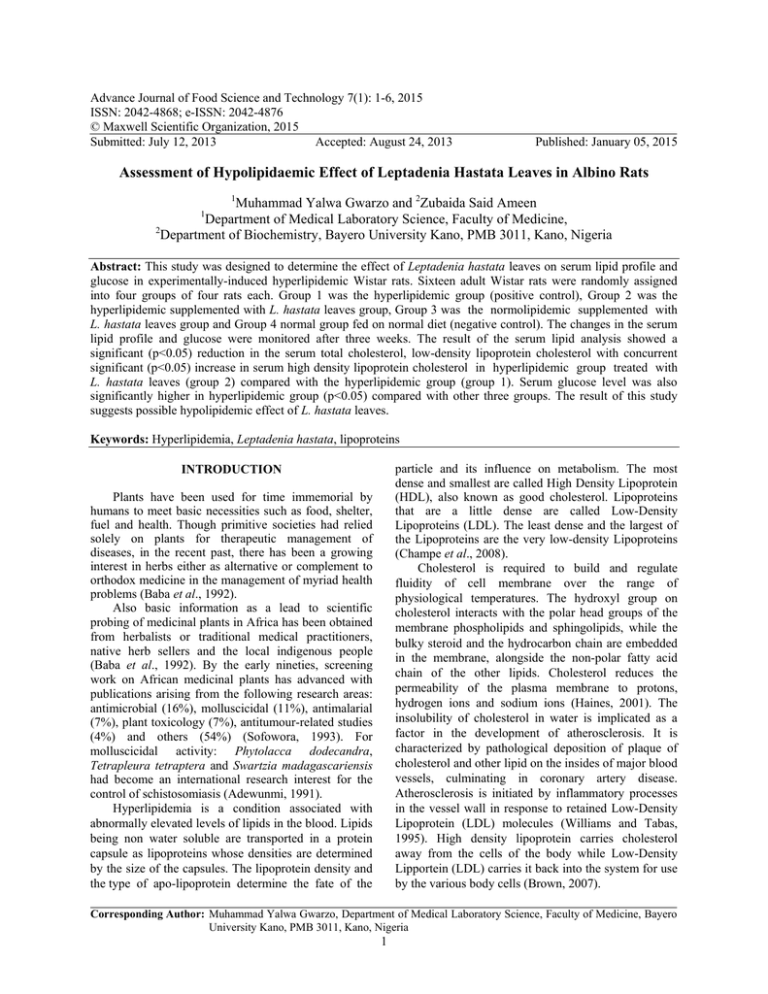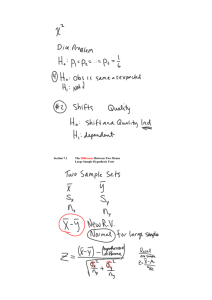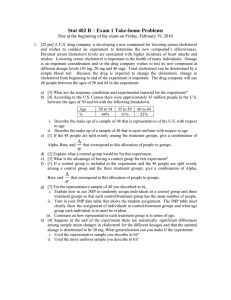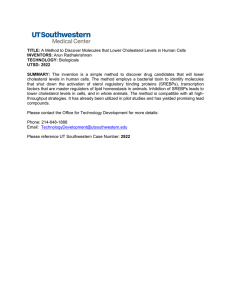Advance Journal of Food Science and Technology 7(1): 1-6, 2015
advertisement

Advance Journal of Food Science and Technology 7(1): 1-6, 2015 ISSN: 2042-4868; e-ISSN: 2042-4876 © Maxwell Scientific Organization, 2015 Submitted: July 12, 2013 Accepted: August 24, 2013 Published: January 05, 2015 Assessment of Hypolipidaemic Effect of Leptadenia Hastata Leaves in Albino Rats 1 Muhammad Yalwa Gwarzo and 2Zubaida Said Ameen Department of Medical Laboratory Science, Faculty of Medicine, 2 Department of Biochemistry, Bayero University Kano, PMB 3011, Kano, Nigeria 1 Abstract: This study was designed to determine the effect of Leptadenia hastata leaves on serum lipid profile and glucose in experimentally-induced hyperlipidemic Wistar rats. Sixteen adult Wistar rats were randomly assigned into four groups of four rats each. Group 1 was the hyperlipidemic group (positive control), Group 2 was the hyperlipidemic supplemented with L. hastata leaves group, Group 3 was the normolipidemic supplemented with L. hastata leaves group and Group 4 normal group fed on normal diet (negative control). The changes in the serum lipid profile and glucose were monitored after three weeks. The result of the serum lipid analysis showed a significant (p<0.05) reduction in the serum total cholesterol, low-density lipoprotein cholesterol with concurrent significant (p<0.05) increase in serum high density lipoprotein cholesterol in hyperlipidemic group treated with L. hastata leaves (group 2) compared with the hyperlipidemic group (group 1). Serum glucose level was also significantly higher in hyperlipidemic group (p<0.05) compared with other three groups. The result of this study suggests possible hypolipidemic effect of L. hastata leaves. Keywords: Hyperlipidemia, Leptadenia hastata, lipoproteins particle and its influence on metabolism. The most dense and smallest are called High Density Lipoprotein (HDL), also known as good cholesterol. Lipoproteins that are a little dense are called Low-Density Lipoproteins (LDL). The least dense and the largest of the Lipoproteins are the very low-density Lipoproteins (Champe et al., 2008). Cholesterol is required to build and regulate fluidity of cell membrane over the range of physiological temperatures. The hydroxyl group on cholesterol interacts with the polar head groups of the membrane phospholipids and sphingolipids, while the bulky steroid and the hydrocarbon chain are embedded in the membrane, alongside the non-polar fatty acid chain of the other lipids. Cholesterol reduces the permeability of the plasma membrane to protons, hydrogen ions and sodium ions (Haines, 2001). The insolubility of cholesterol in water is implicated as a factor in the development of atherosclerosis. It is characterized by pathological deposition of plaque of cholesterol and other lipid on the insides of major blood vessels, culminating in coronary artery disease. Atherosclerosis is initiated by inflammatory processes in the vessel wall in response to retained Low-Density Lipoprotein (LDL) molecules (Williams and Tabas, 1995). High density lipoprotein carries cholesterol away from the cells of the body while Low-Density Lipportein (LDL) carries it back into the system for use by the various body cells (Brown, 2007). INTRODUCTION Plants have been used for time immemorial by humans to meet basic necessities such as food, shelter, fuel and health. Though primitive societies had relied solely on plants for therapeutic management of diseases, in the recent past, there has been a growing interest in herbs either as alternative or complement to orthodox medicine in the management of myriad health problems (Baba et al., 1992). Also basic information as a lead to scientific probing of medicinal plants in Africa has been obtained from herbalists or traditional medical practitioners, native herb sellers and the local indigenous people (Baba et al., 1992). By the early nineties, screening work on African medicinal plants has advanced with publications arising from the following research areas: antimicrobial (16%), molluscicidal (11%), antimalarial (7%), plant toxicology (7%), antitumour-related studies (4%) and others (54%) (Sofowora, 1993). For molluscicidal activity: Phytolacca dodecandra, Tetrapleura tetraptera and Swartzia madagascariensis had become an international research interest for the control of schistosomiasis (Adewunmi, 1991). Hyperlipidemia is a condition associated with abnormally elevated levels of lipids in the blood. Lipids being non water soluble are transported in a protein capsule as lipoproteins whose densities are determined by the size of the capsules. The lipoprotein density and the type of apo-lipoprotein determine the fate of the Corresponding Author: Muhammad Yalwa Gwarzo, Department of Medical Laboratory Science, Faculty of Medicine, Bayero University Kano, PMB 3011, Kano, Nigeria 1 Adv. J. Food Sci. Technol., 7(1): 1-6, 2015 group 2 were fed cholesterol, butter, feed and extract. Group 3 were given only feed and extract, then lastly the control were given only normal feed. Accumulation of LDL molecules on the vessel walls enhances their susceptibility to oxidation by free radicals and become potentially toxic to the cell leading to the damage of the arteries. Such damage caused by oxidized-LDL invokes immune system response by sending specialized white blood cells (macrophages and T-lymphocytes) to absorb the oxidized-LDL forming specialized foam cells. These white blood cells are not able to process the oxidized-LDL and ultimately grow and then rupture, depositing a greater amount of oxidized cholesterol into the artery wall. This triggers more white blood cells continuing the cycle (Sparrow and Olszewski, 1993). Asciepiadaceae plants to which Leptadenia hastata is a family were associated with various potential therapeutic effects. Leptadenia hastata is a twiner with a corky on the older stems, well developed half succulent and persistent petiole leaves with a thick greenish sap. The leaves are more abundant and fresh during rainy season (Aliero et al., 2001). The plant has been reported to be safe with low LD 50 of 1513 mg/kg (Tambaura et al., 2005). It contains triterpenes, fatty acids, amino acids, polyoxypregnane, lutein and Bcarotene (Aquino et al., 1996; Nikiema et al., 2007; Tambaura et al., 2005) and selenium and phosphorus (Freiberger et al., 1998). In this study the possible hypolipidemic potential of Leptadenia hastata leaves were investigated in animal model of hyperlipidaemia, since it is being used in Hausa land in the treatment of hyperlipidemia. Experimental design: Group 1: Hyperlipidemic and were not administered Leptadenia hastata (Hyperlipidemic control) Group 2: Hyperlipidemic and were administered Leptadenia hastate Group 3: Normal but administered Leptadenia hastate Group 4: Normolipidemic not administered Leptadenia hastata but were only given water and food (Normolipidemic Control) Group 1 and 2 were induced nutritionally to be hyperlipidemic by mixing the commercial feed with 40% butter 0.5% cholic acid and 5% cholesterol, but in which the diet of group two was supplemented with 20% Leptadenia hastata leaves. Group 3 were given commercial feed and 20% Leptadenia hastata. Group 4 was normolipidemic control fed on 100% normal commercial diet. Sample collection: At the end of 21 days period, the rats were sacrificed by suffocation with carbon IV oxide to make the animals unconscious followed by surgical dislocation utilizing a stick. Blood samples were collected followed by centrifuging to collect serum for biochemical analysis. Analytical procedures: The serum thus obtained was used for total cholesterol, HDL-Cholesterol and Triglycerides estimation. Serum total cholesterol was estimated using method of Flegg (1973), estimation of Triglycerides by Mendez et al. (1975) and HDLcholesterol by Lopez-Vitrella et al. (1977), LDLcholesterol values were estimated by a modification of Friedwald formula (Sandkamp et al., 1990). Serum glucose was estimated by the method of Glucose Oxidase Method (Barham and Trinder, 1972). MATERIALS AND METHODS Chemicals: All chemicals unless otherwise stated were purchased from Randox Laboratories LTD (Ardmore, Diamond Road) United Kingdom. Plant materials: The leaves of L. hastata were collected from natural habitat in Kano state, Nigeria in 2011. The leaves were sorted to remove the dead ones, washed to remove debris and dust particles and sundried for four days. The dried leaves were milled to get a course provider. Phytochemical screening: The methods of Harborne (1973), Sofowora (1993) and Trease and Evans (1983) were used to identify the following phytochemicals in the extracts: Saponins, Tannins and Glycosides. Study subject: Sixteen male albino rats weighing between 80-100 g purchased from Biology Laboratory Bayero University Kano were used. All aspect of animal care compiled with the ethical guidelines and technical requirement approved by the Institutional Animal Ethics Committee of the Department of Biochemistry, Bayero University, Kano, Nigeria. The experiment was carried out in Biological science Laboratory after a week of purchased. The albino rats were divided into four groups of four rats per group (groups 1, 2, 3 and 4). Animals in group 1, 2 and 3 were fed with different amount of supplement while group 4 animals serve as control. Group 1 was given cholesterol; butter and feed, Statistical analysis of data: The data were analyzed using descriptive and inferential statistics. All values were presented as mean±Standard Error of Mean (S.E.M.) for four rats in each of the four groups of rats. The significance of difference in all the means of all parameters reported for the four groups of animals was determined using paired sample student t-test and a pvalue of <0.05 (two failed) was considered as significant. RESULTS Table 1 shows the effect of Leptadenia hastata on serum lipid profile and serum glucose in both induced 2 Adv. J. Food Sci. Technol., 7(1): 1-6, 2015 Table 1: Effect of Leptadenia hastata on serum lipid profile and glucose in experimental rats Total HDL chol. TRLG VLDL chol. LDL chol. Group cholesterol (mmol/L) (mmol/L) (mmol/L) (mmol/L) (mmol/L) Hyperlipidemic control 5.15±0.06 1.64±0.24 1.28±0.21 0.58±0.05 2.74±0.45 Hyperlipidemic on supplement 3.55±0.38* 2.82±0.12* 1.03±0.21 0.48±0.10 0.87±0.08* Normolipidemic on supplement 2.75±0.17 1.68±0.16 0.63±0.22* 0.32±0.21 0.41±0.02* Normolipidemic on normal diet 2.93±0.05 2.68±1.99 0.70±0.14* 0.35±0.04 0.30±0.11* *: Statistically significant at (p<0.05); Results are mean+S.E.M. (standard error of the mean); Number of experimental animals each group = 4 Table 2: Phytochemical screening of fresh and dried leaves extracts of Leptadenia hastata Phytochemical Relative amount of dried leaves Tannins ++ Saponins +++ Flavonoids ++ Volatile oils + Anthroquinones Phenolic glycosides + Alkaloids ++ +: Trace amount; +++: Presence; -: Absence Glucose (mmol/L) 5.95±0.29 4.89±0.24* 4.08±0.74* 4.18±0.11* human atherosclerosis that oxidized lipids derived from LDL contribute to many of the stages of atherosclerotic development (Heineke, 1998). Mechanisms that have been proposed to result in enhanced Lipoprotein oxidation either locally and systemically and the progression and the development of atherosclerosis include increased production of tumour necrosis factor and other cytokines; up regulation of NADPH oxidase (s) and other oxidative enzymes in vascular tissues and increases in the renin angiotensin system (Brasier et al., 2002). Overweight and obesity are associated with significantly increased mortality from atherosclerotic cardiovascular disease and other causes. Obesity is also associated with major risk factors for atherosclerosis including hyperlipidemia, diabetes mellitus, hypertension and metabolic syndrome (Brasier et al., 2002). The human loss and financial cost associated with hyperlipidaemia is highly enormous in the United states, with estimated 100,00 death and management cost to the tune of $200 m annually (American Heart Association, 1997). The relationship between coronary heart disease and elevated serum cholesterol has been well established, prompting cardiologists to prescribe lipid lower agents to patients with coronary artery disease and hyperlipidemia (Daskalopoulou and Mikhailidis, 2006; Taylor et al., 2013). It is strongly associated with lifestyle characteristic of an affluent society and thus, rapid change of life style in developing countries predisposes people to hyperlipidemia and hence greater chances of developing heart attack (Taylor et al., 2013). Faulty diet is a very common cause of heart disease; therefore strong inclination to fast food rich in saturated fats has led to increase in Coronary Heart Disorder (CHD) in the developing countries (Kulkarni and Gurpreet, 1999). There is a reservoir of basic information on the use of herbs throughout the globe in the management or control of hyperlipidemia. Antihyperlipidemic activities of Calotropis procera and Gymenma sylvestre respectively were well reported (Bayala et al., 2011; Rachh et al., 2010). Chavda et al. (2010) found that Calotropis procera root bark has significant antioxidant and hepatoprotective potentials. However, Leptadenia hastata an edible plant of Tropical Africa has showed anti-inflammatory action (Nikiema et al., 2007) and its inhibitory effect on certain tumoral cells (Aquino et al., 1996). The plant is used in the treatment of scabies hypertension, catarrh and skin diseases (Thomas, 2012). Aqueous extract of leaf stem Leptadenia hastata has hyperlipidemic and normolipidemic rats. The table shows that the administration of Leptadenia hastata leaves to the rats reduced the serum lipid profile of the rats. The HDL value for rats administered with Leptadenia hastata was higher than the hyperlipidemic control. There was significant reduction of total cholesterol, triglycerides, LDL cholesterol and VLDL in hyperlipidemic rats administered Leptadenia hastata leaves compared with hyperlipidemic control (p<0.05). The total cholesterol level reduced from 5.15 mmol/L±0.06 to 3.55 mmol/L±0.38, the triglycerides level reduced from 1.28 mmol/L±0.21 to 1.03 mmol/L±0.2. Similarly the serum VLDL level was also reduced from 0.58 mmol/L±0.05 to 0.48 mmol/L±01.10, while the LDL level was reduced from 2.74 mmol/L±0.45 to 0.87 mmol/L±0.08. Serum glucose levels also decreases from 5.95 mmol/L±0.29 to 4.89 mmol/L±0.24. Conversely, the was a significant increase in HDL levels in hyperlipidaemic rats administered with Leptadenia hastata compared with hyperlipidaemic control (p<0.05). Similarly there was significant difference in hyperlipidemic rats administered with Leptadenia hastata leaves in the level of serum glucose compared with hyperlipidemic control (p<0.05). For group 3, with also sub-groups on normal and administered Leptadenia hastata leaves, respectively, there was reduction in total cholesterol and LDL values, as well as serum glucose level compared with hyperlipidemic control group (p<0.05). Table 2 shows the result of phytochemical analysis. The evaluation revealed the presence of flavanoids, tannins and alkaloids among other classes of compounds. Anthroquinones have not been identified. DISCUSSION Obesity and hyperlipidemia have been implicated as etiologic factors of atherosclerosis and heart attack. There is evidence both in vitro and in animal models of 3 Adv. J. Food Sci. Technol., 7(1): 1-6, 2015 been reported to reduce the progressive velocity, linearity and sperm motility of male Wistar rats (Bayala et al., 2011). Though the plant has been associated with myriads of therapeutic functions, there is paucity of information on its use as hypolilpidemic agent. Though Bello et al. (2011) have reported reduction of serum VLDL-C in alloxan induced diabetes, it had not been shown to have the potential of reducing LDL-C. In Hausa land Leptadenia hastata is used in the management of hyperlipidemia. In this study treatment with Leptadenis hastata produced a significant decrease in the serum lipids in induced hyperlipidemic rats which may be due to certain phytochemicals which act as primary antioxidant with high redox potentials and singlet oxygen quenching capacity (Kahkonen et al., 1999). Leptadenis hastata contain phytosterols which is reported as useful in the treatment of hyperlipidemia (Sudhessh et al., 1996). From the present data the levels of total serum cholesterol, triglyceride and LDL lipoprotein had been lowered significantly with Leptadenia hastata. Hence, it can be utilized in providing dietary management in the prevention of atherosclerosis obesity and hyperlipidemia. Phytochemicals such as flavonoids have been detected. Flavonoids are shown to act by inhibiting cholesterol esterase with the potential effect of treating obesity (Sivashanmugam et al., 2013) as well as inhibiting Coenzyme A reductase and Cholesterol acyl transferases thereby lowering serum cholesterol (Lee et al., 1999). Flavonoids also activate cAMP synthesis, with subsequent activation of protein kinase. Protein kinase increases triacyglycerol hydrolysis with consequent reduction in blood and liver triglycerides and VLDL (Yang et al., 2004). Furthermore flavonoids activate LDL receptors (Kirk et al., 1998) as well as preventing the macrophage oxidation of LDL cholesterol, hence have the potential of inhibiting atherosclerosis (De Whalley et al., 1990). Flavonoids are also reported to have anti atherogenic and thrombogenic effect on macrophage and platelet functions as well as inhibiting enzymes such as (phospholipase A2, cyclooxygenase and lipoxigenase (Frankel et al., 1993). Polyphenols such as flavonoids and tannins have been shown to have numerous health protective benefits, which include lowering of blood lipids (Hayashi et al., 2002). Methoxylated flavonoids of citrus appear to have the potent effect of modulating liver lipid metabolism by suppressing apoB-containing lipoprotein secretion (Hayashi et al., 2002). Apolipo proteinB (apoB) is the primary lipid transport protein for Low Density Lipoproteins (LDL) and high levels are related to heart disease (Hayashi et al., 2002). Citrus flavonoids such as tangeretin and nobelatin inhibit apoB secretion with modest reduction in cholesterol deposition by apoB, a key player play in LDL-cholesterol transport and removal. Reduction in Apo B synthesis is expected to reduce circulating LDL cholesterol, a proven risk factor of cardiovascular disease (Lin et al., 2011). Thus it can be suggested that the polyphenol contents in the extract may impact hypolipidaemic property of the leaves of Leptadenia hastata. From the present data the levels of total serum total cholesterol and triglyceride were lowered significantly with Leptadenia hastata. These therapeutic effects are likely associated with the constituents phytochemicals such as flavonoids which were demonstrated to have the potentials of lowering serum lipid, due to their ability to enhance esterification of cholesterol, prevention of macrophage oxidation of lipids, increased triglycerides hydrolysis via induction of protein kinases and inhibition of oxidative enzymes. Thus, the use of leaves of Leptadenia hastata widely used in Hausaland as anti-hyperlipidaemic agent can be justifiably advocated as part of therapeutic measures to control hyperlipidaemia, with the anticipated consequence of reducing coronary heart disease, management of obesity and treatment of hypertensive complications. REFERENCES Adewunmi, C.O., 1991. Plant molluscicides: Potential of Aridan, Tetrapleura tetraptera, for schistosomiasis control in Nigeria. Sci. Total Environ., 102: 21-33. Aliero, B.L., M.A. Umaru, H.A. Suberu and A. Abubakar, 2001. A Hand Book of Common Plants in North Western Nigeria. Usman Danfodiyo University Press, Sokoto, Nigeria, pp: 78-79. American Heart Association, 1997. Heart and Stroke Statistical Uptade. American Heart Association, Dallas. Aquino, R., G. Peluso, N. De Tommasi, F. De Simone and C. Pizza, 1996. New polyoxypregnane ester derivatives from Leptadenia hastate. J. Nat. Prod., 59(6): 555-564. Baba, S., O. Akerede and Y. Kawguchi, 1992. Natural ressources and human health: Plants of medicinal and nutritional value. Proceeding of the 1st WHO Symposium on Plants and Health for All: Scientific Advancements. Kobe, Japan, August 26-28, 1991. Barham, D. and P. Trinder, 1972. An improved colour reagent for the determination of blood glucose by the oxidase system. Analyst, 97(151): 142-5. Bayala, B., P.B. Telefo, I.H.N. Bassole, H.H. Tamboura, R.G. Belemtougri, L. Sawadogo, B. Malpaux and J.L. Dacheux, 2011. Antispermatogenic activity of Leptadenia hastata (Pers.) Decne Leaf Stems Aqueous Extracts in Male Wistar Rats. J. Pharmacol. Toxicol., 6: 391-399. 4 Adv. J. Food Sci. Technol., 7(1): 1-6, 2015 Kahkonen, M.P., A.I. Hopia, H.J. Vuorela, J.P. Rauha, K. Pihlaja, T.S. Kulaja and M. Heinonen, 1999. Antioxidant activity of plant extracts containing phenolic compound. J. Agr. Food Chem., 47: 3954-3962. Kirk, E.A., P. Sutherland, S.A. Wang, A. Chait and R.C. LeBoeuf, 1998. Dietary isoflavones reduce plasma cholesterol and atherosclerosis in C57BL/6 mice but not LDL receptor-deficient mice. J. Nutr., 128: 954-9. Kulkarni, S.K. and K. Gurpreet, 1999. Obesity: An insight into its neurochemical basis and treatment. Indian J. Pharmacol., 31: 388-403. Lee, S.H., Y.B. Park, K.H. Bae, S.H. Bok, Y.K. Kwon, E.S. Lee and M.S. Choi, 1999. Cholesterollowering activity of naringenin via inhibition of 3hydroxy-3-methylglutaryl coenzyme: A reductase and acyl coenzyme A: Cholesterol acyltransferase in rats. Ann. Nutr. Metab., 43(3): 173-80. Lin, Y., M.A. Vermeer, W. Bos, L. van Buren, E. Schuurbiers, S. Miret-Catalan and E.A. Trautwein, 2011. Molecular structures of citrus flavonoids determine their effects on lipid metabolism in HepG2 cells by primarily suppressing ApoB secretion. J. Agr. Food Chem., 59(9): 4496-503. Lopez-Vitrella, M.F., P. Stone, S. Ellis and J.A. Coltwell, 1977. Cholesterol determination in high density lipoprotein separated by three different methods. Clin. Chem., 23: 882-884. Mendez, A., J. Fraklein and B.H. Slahegan, 1975. Simple manual method for determination of serum triglycerides. Clin. Chem., 21: 760-770. Nikiema, J.B.R., M. Vanhaelen-Fastre, J. Vanhaelen, C. Fontaine and M.T. Olaleye, 2007. Cytotoxicity and antibacterial activity of methanolic extract of Hibiscus sabdariffa. J. Med. Plants Res., 1(1): 9-13. Rachh, P.R., M.R. Rachh, N.R. Ghadiya, D.C. Modi, K.P. Modi, N.M. Patel and M.T. Rupureliya, 2010. Antihyperlipidemic activity of gymenma sylvestre R.Br. leaf extract on rats fed with high cholesterol diet. Int. J. Pharmacol., 6: 138-141. Sandkamp, M., H. Funke, M. Schulter, E. Kahlar and G. Assman, 1990. Lipoprotein(a) is an independent risk factor for myocardial infarction at a young age. Clin. Chem., 36: 20-23. Sivashanmugam, T., S. Muthukrishnan, M. Umamaheswari, K. Asokkumar, V. Subhadradevi, P. Jagannath and A. Madeswaran, 2013. Discovery of potential cholesterol esterase inhibitors using in silico docking studies. Bangladesh J. Pharmacol., 8: 223-229. Sofowora, A., 1993. Medicinal Plant and Traditional Medicine in Africa. 2nd Edn., Spectrum Books, Ibadan, Nigeria, 38: 201-214. Sparrow, C.P. and J. Olszewski, 1993. Cellular oxidation of low density lipoprotein is caused by thiol production in media containing transition metal ions. J. Lipid Res., 34(7): 1219-28. Bello, A., A.A. Aliero, Y. Saidu and S. Muhammad, 2011. Hypoglycaemic and hypolipidaemic effects of Leptadenia hastata (Pers.) decne in alloxan induced diabetic rats. Nigerian J. Basic Appl. Sci., 19(2): 187-192. Brasier, A.R., A. Recinos and M.S. Eledrisi, 2002. Vascular inflammation and the rennin-angiotensin system. Arterioscl. Throm. Vas., 22(8): 1257-1266. Brown, W.V., 2007. High-density lipoprotein and transport of cholesterol and triglyceride in blood. J. Clin. Lipidol., 1: 7-19. Champe, P.C., R.A. Hasvey and D.R. Ferrier, 2008. Lippincott’s Illustrated Review: Biochemistry. 4th Edn., Lippincott Williams and Wilkins, Philadelphia, pp: 173-219. Chavda, R.K., R. Vadalia and R. Gokani, 2010. Hepatoproactive and antioxidant activity of root bark of calotropis procera R. Br (Asclepediaceae). Int. J. Pharmacol., 6: 937-943. Daskalopoulou, S.S. and D.P. Mikhailidis, 2006. Reaching goal in hypercholesterolaemia: Dual inhibition of cholesterol synthesis and absorption with simvastatin plus ezetimibe. Curr. Med. Res. Opin., 22(3): 511-28. De Whalley, C.V., S.M. Rankin, J.R. Hoult, W. Jessup and D.S. Leake, 1990. Flavonoids inhibit the oxidative modification of low density lipoproteins by macrophages. Biochem. Pharmacol., 39(11): 1743-50. Flegg, H.M., 1973. An investigation of the determination of serum cholesterol by an enzymatic method. Ann. Clin. Biochem., 10: 79-84. Frankel, E.N., A.L. Waterhouse and J.E. Kinsella, 1993. Inhibition of human LDL oxidation by resveratrol. Lancet, 341(8852): 1103-4. Freiberger, C.E., D.J. Vandergat, A. Pastuszyn, R.S. Glew, G. Mounkarla, M. Millson and R.H. Glew, 1998. Nutrient content of edible leaves of seven wild plants from Niger. Plant Food. Hum. Nutr., 53: 57-59. Haines, T.H., 2001. Sterols reduce proton and sodium leaks through lipid bilayers? Prog. Lipid Res., 40(4): 299-324. Harborne, J.B., 1973. Phytochemical Methods: A Guide to Modern Techniques of Plant Analysis. 2nd Edn., Chapman and Hall, New York, USA, pp: 49-188. Hayashi, T., H. Maruyama, R. Kasai, K. Hattori, S. Takasuga, O. Hazeki, K. Yamasaki and Tanaka, 2002. Ellagitannins from lagerstroemia species as activators of glucose transport in fat cells. Plant Med., 68: 173-175. Heineke, J.W., 1998. Oxidants and antioxidants in the pathogenesis of atherosclerosis: Implications for the oxidized low density lipoprotein hypothesis. Atherosclerosis, 141: 1-15. 5 Adv. J. Food Sci. Technol., 7(1): 1-6, 2015 Sudhessh, S., K.S. Vijay, C. Sandhya and N.R. Vijayalakshmi, 1996. Toxic effects of condensed tannins from solanum melongena on rats. J. Ecotoxicol. Environ. Monit., 6: 221. Tambaura, H.H., B. Bayala, M. Lompo, I.P Guissou and L. Sawadogo, 2005. Ecological distribution, morphological characteristics and acute toxicity of aqueous extracts of Holarrhena Floribunda (G.Don) Durrand & Schinz, Leptadenia hastata (Pers.) decne and Cassia sieberiana DC. Used by veterinary healers in Burkina Faso. Afr. J. Tradit. Complem., 2: 13-24. Taylor, F., M.D. Huffman, A.F. Macedo, T.H. Moore, M. Burke, G. Davey Smith, K. Ward and S. Ebrahim, 2013. Statins for the primary prevention of cardiovascular disease. Cochrane Db. Syst. Rev., 1: CD004816. DOI: 10.1002/ 14651858. CD004816.pub5. Thomas, S.D., 2012. Leptadenia hastata: A review of its traditional uses and its pharmacological activity. Med. Chem., 2(7): 148-150. Trease, G.E. and W.C. Evans, 1983. Textbook of Pharmacognosy. 12th Edn., Tindall, London, UK, pp: 21-22. Williams, K.J. and I. Tabas, 1995. The response-toretention hypothesis of early atherogenesis. Arterioscl. Throm. Vas., 15(5): 551-61. Yang, S., U. Fransson, L. Fagerhus, L.S. Holst, H.E. Hohmeier, E. Renstrom and H. Mulder, 2004. Enhanced cAMP protein kinase: A signaling determines improved insulin secretion in a clonal insulin-producing beta-cell line (INS-1 832/13). Mol. Endocrinol., 18: 2312-2320. 6




